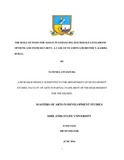Please use this identifier to cite or link to this item:
https://cris.library.msu.ac.zw//handle/11408/2012Full metadata record
| DC Field | Value | Language |
|---|---|---|
| dc.contributor.author | Gwanzura, Tatenda | - |
| dc.date.accessioned | 2017-06-13T09:12:22Z | - |
| dc.date.available | 2017-06-13T09:12:22Z | - |
| dc.date.issued | 2016-06 | - |
| dc.identifier.uri | http://hdl.handle.net/11408/2012 | - |
| dc.description.abstract | It is proving difficult to achieve food security for both developing and developed world. The severity of this problem however is dependent on a country’s ability to cope with stress and shocks. Food aid has become a solution to most of the developing countries in trying to mitigate this challenge. Nyaminyami district is one area that has constantly remained in the top ten of Zimbabwe’s most food insecure districts. The area has been receiving food aid since the year 2000. The food aid has been in different projects such as STA, NSART, Cash transfers and Food for Asset. Although these projects are different in scope the aim was to make Nyaminyami food secure, however the area is still being considered food insecure despite the efforts. It against this background that the researcher sought to investigate the role of FFA in enhancing the household livelihoods options and food security. The research paid much focus on the whether the community livelihoods were improved by this project, there is a change in perception of the community from being dependant on food aid to self-reliant, the extent to which capacity building helps enhancing household livelihoods options and food security and providing recommendations based on the findings. Both qualitative and quantitative techniques were employed to obtain data from a sample size of 220 from both FFA and non-FFA beneficiaries. Focus group discussions, interviews and questionnaires were used to collect data. Probability and non-probability sampling techniques that stratified random sampling and convenience sampling respectively were used to select the sample size. After collection of data, the data were analysed and presented in form of tables, percentages and frequencies. It was found out that FFA changed the livelihoods and food security during its project cycle, however after its implementation the community resorted to their normal livelihoods and is still depending on food aid for their food security for various reasons Following the analysis, recommendations were given based on the findings, it was recommended amongst other recommendations that there is need to consider the five capitals in every development intervention as development hinges on these capital. | en_US |
| dc.language.iso | en | en_US |
| dc.publisher | Midlands State University | en_US |
| dc.subject | Food security, developed world | en_US |
| dc.title | The role of food for assets in enhancing household livelihood options and food security: a case of Nyaminyami district, Kariba rural | en_US |
| item.languageiso639-1 | en | - |
| item.fulltext | With Fulltext | - |
| item.grantfulltext | open | - |
| Appears in Collections: | Master Of Arts In Development Studies | |
Files in This Item:
| File | Description | Size | Format | |
|---|---|---|---|---|
| Tatenda Gwanzura dissertation final.pdf | Full Text | 1.69 MB | Adobe PDF |  View/Open |
Page view(s)
18
checked on Jul 26, 2024
Download(s)
26
checked on Jul 26, 2024
Google ScholarTM
Check
Items in MSUIR are protected by copyright, with all rights reserved, unless otherwise indicated.



